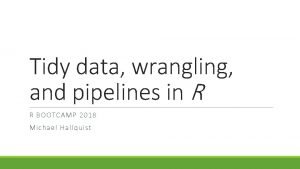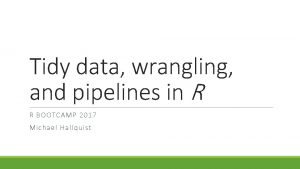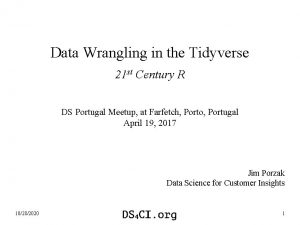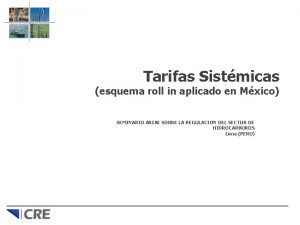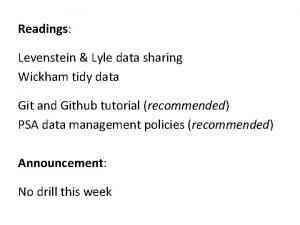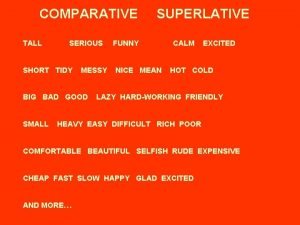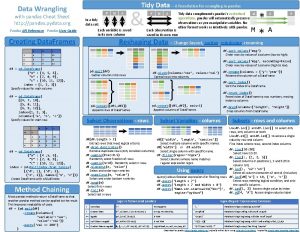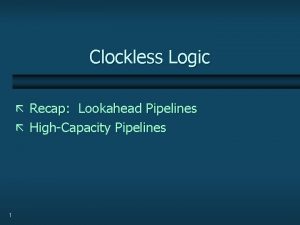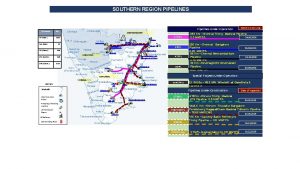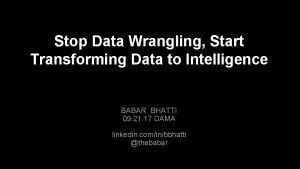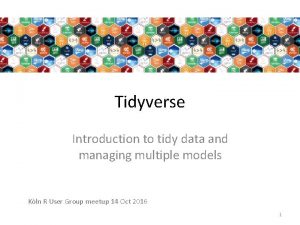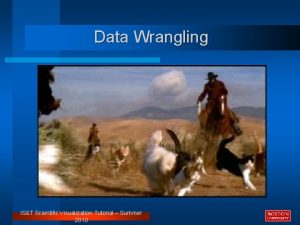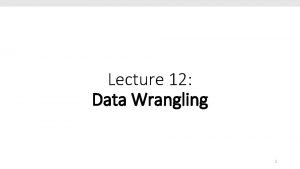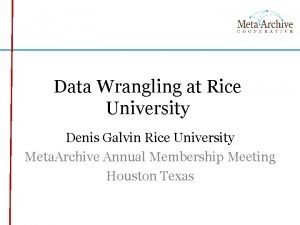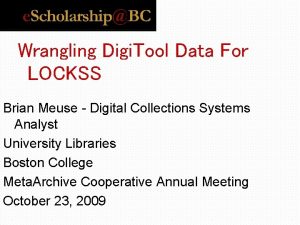Tidy data wrangling and pipelines in R R













![Data pipelines An alternative syntax emerged long ago from Unix terminal programming: [mh ~] Data pipelines An alternative syntax emerged long ago from Unix terminal programming: [mh ~]](https://slidetodoc.com/presentation_image_h/02ab525d7f5a9041feda2a274d093709/image-14.jpg)




- Slides: 18

Tidy data, wrangling, and pipelines in R R BOOTCAMP 2018 Michael Hallquist

Data structure semantics Most data wrangling can be accomplished using data. frame objects (or tbl in dplyr). These objects consist of rows and columns. ◦ Columns are typically labeled (and represent variables) ◦ Rows can be labeled, although often not necessary Datasets contain values: numbers, strings, etc. A value belongs to a variable and an observation. A variable contains all values measuring an attribute (e. g. , neuroticism) across units (e. g. , people) An observation contains all values measured on the same unit across attributes. Wickham 2016 tidyr tutorial

Data structure semantics http: //garrettgman. github. io/tidying/

Data wrangling grammar To communicate effectively about data structure, manipulation, and processing, we need a common set of data wrangling verbs. The data import and transformation cheatsheets (https: //www. rstudio. com/resources/cheatsheets/) provide a succinct overview of the tools we will use in bootcamp. R provides a number of other tools for data management, but does not have a unifying conceptual framework. For clarity in your training, we’ll stick closely to functions in the tidyr and dplyr packages developed by Hadley Wickham From Wickham 2014, 2016

Tidy data 1. Each variable forms a column 2. Each observation forms a row 3. Each type of observational unit (e. g. , persons, schools, counties) forms a table. Variables that are part of the design (participant number, experimental condition, county ID, etc. ), or that may be key categorical moderators, should typically be placed first (to the left), and measured variables thereafter. Wickham 2014

Mess #1: Column headers are values, not var. names Messy Tidy

Data tidying verbs: Gather: combined multiple columns into a single column with a keyvalue pair format From Boehmke 2015

Mess #2: Multiple variables stored in one column Messy Tidy Data tidying verbs: Separate: split a single variable into multiple variables. Useful when values represent many attributes (e. g. , sex and age).

Mess #3: Variables stored in both rows and columns Data tidying verbs: Spread: divide key-value rows into columns Messy Molten Tidy Gather Spread

Summary of data tidying verbs gather: combine multiple columns into a single column with a keyvalue pair format spread: divide key-value rows into columns unite: merge two columns (variables) into one (pasting together) separate: split a single variable into multiple variables. Useful when values represent many attributes (e. g. , sex and age).

Core data wrangling verbs filter: subset or remove observations (rows) select: subset or remove a group of columns (variables) mutate (transform): add or modify one or more variables summarize (aggregate): collapse multiple values into a single value (e. g. , by summing or taking means) arrange (sort): change the order of observations

Other data wrangling verbs join (Merge): Combine datasets on matching variable(s) group_by: divide dataset according to one or more categorical variables (factors) ungroup: Remove grouping from data operations rename: change the names of one or more variables recode: change the values of a discrete variable (especially factor) slice: subset rows based on numeric order distinct: Keep observations that are non-redundant (cf. unique)

Data pipelines Traditional R uses chained function calls to join together data operations: > arrange(summarize(filter(data, variable == numeric_value), Total = sum(variable)), desc(Total)) This syntax extends from combinations of functions in math: f(g(x)), where the functions are evaluated from inner to outer. Although this is not a terrible syntax, it gets confusing to keep track of "the output of this function is the input to the next one. "
![Data pipelines An alternative syntax emerged long ago from Unix terminal programming mh Data pipelines An alternative syntax emerged long ago from Unix terminal programming: [mh ~]](https://slidetodoc.com/presentation_image_h/02ab525d7f5a9041feda2a274d093709/image-14.jpg)
Data pipelines An alternative syntax emerged long ago from Unix terminal programming: [mh ~] find. –iname '*. pdf' | grep –v 'figure' | sort –n The idea of "pipes" and "redirection" in shell scripting is that the command can be read from left to right where the pipe | indicates that the output of left command is provided as input to the right command. This syntax makes multi-step chains easier to see and conceptualize.

Data pipelines The magrittr package introduced a pipe-like operator %>% to support data pipelines in R. It plays well with dplyr: > data %>% filter(variable == "value") %>% summarize(Total = sum(variable)) %>% arrange(desc(Total)) Cf. > arrange(summarize(filter(data, variable == numeric_value), Total = sum(variable)), desc(Total))

Use of "this" dataset in dplyr Sometimes it is useful to refer to the current dataset in data wrangling syntax. Dplyr/magrittr tends to hide this from us for convenience, but it's there under the hood. iris %>% filter(Sepal. Length > 7) is the same as iris %>% filter(. , Sepal. Length > 7) So, ". " refers to the current dataset in dplyr operations. And if you don't specify where the ". " falls, it will always be passed as the first argument to the downstream function.

Join types Inner join: retain (only) observations where this is a match in both datasets (left and right) Left join: Keep all rows in left-hand dataset, add values from righthand dataset where there is a match. Right join: Keep all rows in right-hand dataset, add values from lefthand dataset where there is a match. For non-matching observations on the left, fill in NA Full join: Combine observations from both datasets based on matching key and fill in NA for non-matches.

Special values to watch out for NA: missing ◦ na. rm=TRUE available in many functions ◦ Also, see na. omit(), na. exclude(), na. fail(), na. pass() NULL: null set ◦ Often used when something is undefined Inf: infinite Na. N: Not a number. Result of an invalid computation, e. g. , log(-1) Warnings(): If R mentions a warning in data wrangling, make sure you've handled it or know its origin.
 Data wrangling examples
Data wrangling examples Data wrangling pipeline
Data wrangling pipeline Edge to core to cloud
Edge to core to cloud Wrangling azure cloud
Wrangling azure cloud Wrangling
Wrangling Tidyist
Tidyist Westwood pipelines
Westwood pipelines Ammonia pipelines
Ammonia pipelines Questar pipelines
Questar pipelines Tom coolidge
Tom coolidge Pipelines
Pipelines Wickham tidy data
Wickham tidy data Tidy data principles
Tidy data principles Comparative the funny
Comparative the funny Tidy vs untidy wound
Tidy vs untidy wound Rules superlative
Rules superlative Verb forms
Verb forms Listen 3 hali
Listen 3 hali To see in the past
To see in the past

